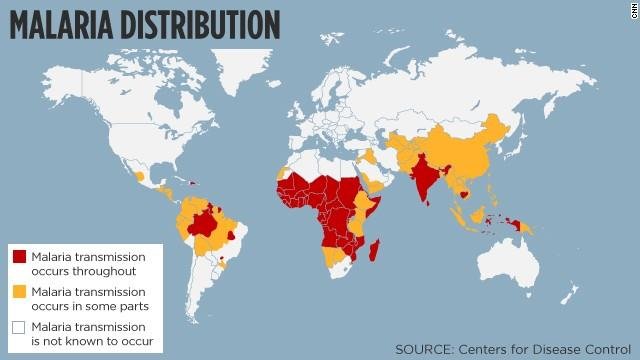Worldwide Distribution of Malaria

Geographic Distribution
Where malaria is found depends mainly on climatic factors such as temperature, humidity, and rainfall.
Malaria generally occurs in areas where environmental conditions allow parasite multiplication in the vector.
Temperature is particularly critical. Thus, at temperatures below 20°C (68°F), ), Plasmodium falciparum (which causes severe malaria) cannot complete its growth cycle in the Anopheles mosquito, and thus cannot be transmitted.
In tropical and subtropical areas, where Anopheles mosquitoes can survive and multiply, the Malaria parasites can complete their growth cycle in the mosquitoes.
| Parasite | Host | Geographical distribution |
| P. vivax | Human | Africa, Asia, South/Central America |
| P. malariae | Human | Africa, Asia, South/Central America |
| P. ovale | Human | Africa |
| P. falciparum | Human | Africa, Asia, South/Central America |
| P. knowlesi | Human/monkeys | Asia |
Trends in the Burden of Malaria
Malaria cases:
- Globally, there were an estimated 229 million malaria cases in 2019 in 87 malaria endemic countries, declining from 238 million in 2000.
At the Global technical strategy for malaria 2016–2030 (GTS) baseline of 2015, there were 218 million estimated malaria cases.
- Twenty-nine countries accounted for 95% of malaria cases globally. Nigeria (27%), the Democratic Republic of the Congo (12%), Uganda (5%), Mozambique (4%) and Niger (3%) accounted for about 51% of all cases globally.
- The World Health Organization (WHO) African Region, with an estimated 215 million cases in 2019, accounted for about 94% of cases.
Malaria deaths:
- Globally, malaria deaths have reduced steadily over the period 2000–2019, from 736000 in 2000 to 409000 in 2019.
The percentage of total malaria deaths among children aged under 5 years was 84% in 2000 and 67% in 2019.
The global estimate of deaths in 2015, the GTS baseline, was about 453000.
- About 95% of malaria deaths globally were in 31 countries.
Nigeria (23%), the Democratic Republic of the Congo (11%), the United Republic of Tanzania (5%), Mozambique (4%), Niger (4%) and Burkina Faso (4%) accounted for about 51% of all malaria deaths globally in 2019.
Malaria cases and deaths averted:
- Most of the cases (82%) and deaths (94%) averted were in the WHO African Region, followed by the WHO South-East Asia Region (cases 10% and deaths 3%).
Content sources:
1.Global Health, Division of Parasitic Diseases and Malaria
URL: https://www.cdc.gov/malaria/malaria_worldwide/impact.html
2.World malaria report 2020: 20 years of global progress and challenges, World Health Organization 2020
URL: https://www.who.int/teams/global-malaria-programme/reports/world-malaria-report-2020
|